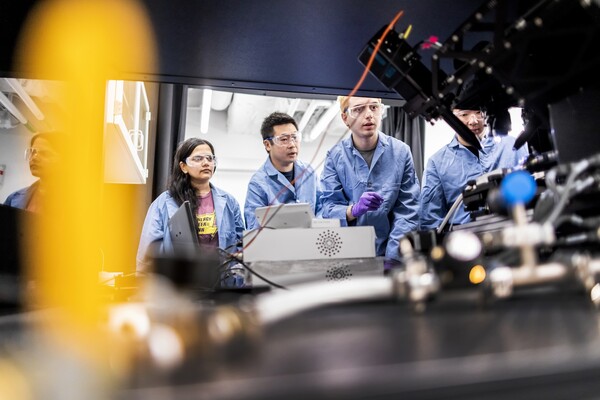
nocred

Light poured in from a wall of windows overlooking the Delaware River as Penn students gathered around a table lined with artifacts in the Independence Seaport Museum’s archives. Craig Bruns, the museum’s chief curator, directed the group’s attention to a deconstructed, illustrated journal of a sailor, one that had literally been cut into pieces by someone enamored of the maker’s beautiful, detailed drawings of seascapes.
“That’s kind of the way that archives and collections occur,” Bruns says. “Maybe at one point there was a whole idea, an intention, and it got separated from what we now have in front of us. In our research, as archivists, we’re digging through what remains to try to put that narrative back together again.”
In a research-based fellowship program this summer, this group of Penn graduate and undergraduate students are creating new narratives of their own, tied to water.
For 10 weeks, the fellows, together with faculty members and guest experts, have taken part in a range of collaborative discussions, independent research, river excursions, and field trips to sites like the Seaport Museum as a means of developing new understandings of urban waters that bridge the arts and sciences. To culminate their summer fellowships, they are developing final projects, which they will present later this month.
The summer research group is part of the Penn Program in the Environmental Humanities (PPEH), headed by Bethany Wiggin, an associate professor of German in the School of Arts and Sciences.
“What seems most profound to me about this summer is the kind of learning community that we were able to create,” Wiggin says. “That has had a lot to do with being open to experimental pedagogies, and being willing to say, ‘I’m an expert in this,’ but also owning it when you’re not.”
The fellows kicked off their summer with two weeks of readings, writing exercises, and discussions about the past, present, and future of Philadelphia’s waterways, and developing their web and social media presence. The introductory period gave fellows with a clear idea of their project scope a chance to reflect, while those whose projects were still taking shape had time to refine their plans.
But the heart of the summer experience for the fellows took place during the subsequent two weeks, with the “On-Water Intensive,” an initiative organized by PPEH in collaboration with Drexel University and its Academy of Natural Sciences. Daily excursions took the fellows to different sites around the city, including the Wissahickon Creek, Fairmount Water Works, Bartram’s Garden, and Penn’s Landing, to conduct research—not in a traditional sense, but using cross-disciplinary lenses and a unique blend of art and science.
Wiggin’s colleague, atmospheric scientist Peter DeCarlo, an associate professor at Drexel, co-led the Intensive, and the summer fellows were joined, depending on the day, by a variety of collaborators, including artists and PPEH’s Community River Fellows.
One goal of the Intensive was a performative one: to conduct research about urban waters that can be shared publicly.
“In particular, the Community River Fellows, who came from the Seaport Museum and Bartram’s Garden and other places, helped us stay connected, and really think about the question of which public audiences might interact with the research we were producing, who might need it, who will be able to access it and how, and what questions they might have and want researched,” Wiggin says.
The group kayaked on the Schuylkill River, donned waders to enter the Wissahickon, and created floating monuments or love letters to the Schuylkill, crafted from detritus they gathered from its banks.
At one point during the experience, a few students set off with Wiggin and David Barnes, an associate professor of history and sociology of science who participated in the Intensive, in an attempt to walk historic Mingo Creek, a stream that has since been mostly buried underground, channeled through pipes.
“We were initially guided by the collaborative group of artists from Walk Around Philadelphia, but we decided in our great wisdom to bushwhack through this one swamp because it seemed closer to the creek, and we ended hard up against a seven- or eight-foot chain link fence,” Wiggin recalls.
The group decided to continue working toward their objective, boosting each other over the obstacle, and later reflecting on not only the layered meanings of the barrier to water access, but also about how the unfamiliar environment unsettled and reframed the group’s interactions.
“We’re writing a collaborative essay about that walk,” Wiggin says, “about the ways in which, when you’re in these strange spaces, hierarchies—like the professor-student relationship—can break down.”
One of the members of that intrepid fence-crossing group, PPEH summer fellow Rose Nagele, now a rising senior at Penn, grew up in Elkins Park, Pa., just outside Philadelphia city limits. She had frequent encounters with the Philadelphia area’s waterways before coming to Penn, biking along Kelly Drive, with scenic views of the Schuylkill River. But the On-Water Intensive gave her a new intimacy with the creeks and rivers that flow through the city.

“This was the closest contact I’ve ever had with the Schuylkill River, which, when I thought about it, was surprising since I’ve lived here my whole life,” she says.
Nagele first learned that environmental humanities existed as a field of study in an anthropology course she took her sophomore year with Nikhil Anand, an assistant professor at Penn. The concept resonated with Nagele, herself a biology major with a creative writing minor.
“We talked about the definition of nature and the definition of culture, and where the line is drawn between the two,” Nagele says. “It’s a central question in environmental humanities, and I had never had that conversation before. That was really an eye-opening class for me.”
Nagele has since sought out other opportunities to explore the relationship between humans and nature. When she heard of the summer fellowship, she jumped at the chance to participate.
We talked about the definition of nature and the definition of culture, and where the line is drawn between the two.
PPEH summer fellow Rose Nagele
Following the On-Water Intensive, Nagele and her cohort of fellows have spent several weeks carrying out research for their independent work. Nagele has undertaken two distinct projects. In one, under the guidance of her adviser David Barnes, she’s conducted oral histories and delved into historic archives to collect stories of how residents of Delaware County’s Tinicum Township view water, specifically the Delaware River that makes up the municipality’s southern border.
“The river has had a big presence in their lives,” Nagele says. “One woman who I’ve talked with the most, her grandfather owned the marina so she had tons of access to the water growing up. Other people have said, ‘Oh no, I wasn’t allowed to go near the river, if my parents heard that I had been near the river, I would be in trouble.’
“Even in those cases, the river has a presence, but a presence as a dangerous thing.”
Rather than write up a report or paper detailing her findings, Nagele is creating a map of the township, labeled with audio excerpts from the oral histories she’s taken, scans of old newspaper clippings, and other artifacts that convey the story of the residents’ relationship with the river during the past century or more.
“Ultimately, I think having these stories spatially represented will help show how this community interacts with the water and how that has changed over time,” Nagele says.
Nagele is pursuing her second project advised by Wiggin, examining the relationship between river ports, Quaker communities, and enslaved Africans in pre-revolutionary Philadelphia. While Quakers are often thought of as fierce abolitionists, some were in fact slave owners and traders until the end of the 18th century.
“I’ve been tracing who was trading slaves, what labor they were being used for, how they were coming into the colony, and where they were going from here,” Nagele says.
Her initial research has revealed instances when enslaved Africans were brought to the Philadelphia region, shipped alongside merchandise such as rum or molasses aboard boats sailing from Barbados—a part of history shamefully linking human experience to the waters that render Philadelphia a port city.
Skipping ahead a few centuries, senior Jolie Gittleman, another PPEH summer research fellow, is engaged in research on contemporary water issues. By transcribing and distilling focus group interviews with Philadelphians about their views on the water that runs from their taps, Gittleman, a fine arts major and biology minor from West Bloomfield, Mich., is identifying key themes about how residents understand and engage with their domestic water.
“The focus groups were designed to gauge the level of water health literacy in Philadelphia,” says Gittleman, who is working under the guidance of Tom McKeon, a postdoctoral researcher with Marilyn Howarth at the Center for Excellence in Environmental Toxicology in Penn’s Perelman School of Medicine. “They asked people, do you know how your water is treated, do you know where your stormwater goes, do you know what a watershed is?”

To address areas of mistrust or lack of knowledge, Gittleman is working with McKeon to develop a water literacy calendar, each month illustrated with informative graphics.
“We’re hoping to distribute the calendar in PDF format to community centers around the city,” Gittleman says. “We want it to be something that people will keep on hand in their homes and use.”
This project matches well with Gittleman’s interest in using visual tools to relate complex information. It’s a pursuit she aims to continue in a career as a medical illustrator.
“I am a super-visual learner; I always have been,” she says. “I always loved how pictures brought out so much when I was learning, even when I was a little kid. To a layman, the art world can seem kind of ephemeral, so I want to apply art to something with a concrete purpose, helping people understand their bodies, which can sometimes seem so mysterious.”
For Wiggin, the summer fellowship program and especially the On-Water Intensive provided an opportunity to stretch and experiment with ways of teaching as part of a team of interdisciplinary experts.
“The students saw us, the instructors, model the kinds of conversations that were both generous and rigorous in this mixed-up watery space,” Wiggin says. “One student wrote in an evaluation that that was one of the most important things that came out of it, just seeing a model for ways to interact when you don’t quite know yet what disciplines will inform your research question.”
What seems most profound to me about this summer is the kind of learning community that we were able to create.
Bethany Wiggin, PPEH leader and associate professor of German in the School of Arts and Sciences
Wiggin and the PPEH team will further these explorations through several initiatives in the fall. One is a new podcast series examining the urgency of protecting and preserving datasets related to the environment and climate change, an outgrowth of the Data Refuge project.
Another is a continuation of the Rising Waters program, a part of the School of Arts and Sciences’ “Making a Difference in Diverse Communities” initiative. Together with her co-director Nikhil Anand, Wiggin will teach an undergraduate seminar and lead a trip to Mumbai, India, where students will delve into questions of how sea-level rise influences cities across the globe.
Nagele feels fortunate to have been chosen as one of the fellows who will travel to Mumbai with Wiggin and Anand, embarking on yet another research endeavor, this time focusing on the past, present, and future of Philadelphia Navy Yard.
“There are obviously so many differences, but there are also a lot of parallels between Mumbai and Philadelphia,” Nagele says. “I’ve traveled to the rainforest and other places to study ecology and the environment, but what I’ve come to realize is that there is so much ecology even in urban areas. Even if it’s a disturbed, industrialized ecology, it’s fascinating, and it’s ignored.”
With their efforts, Nagele, Gittleman, Wiggin, Anand, and their PPEH colleagues are changing that, creatively piecing together knowledge to construct new narratives and ways of understanding the environment—and humans’ role within it.
Homepage photo: Fellows, together with faculty members and guest experts, have taken part in a range of collaborative discussions, independent research, river excursions, and field trips to sites like the Seaport Museum.
Katherine Unger Baillie

nocred

Image: Pencho Chukov via Getty Images

The sun shades on the Vagelos Institute for Energy Science and Technology.
nocred

Image: Courtesy of Penn Engineering Today